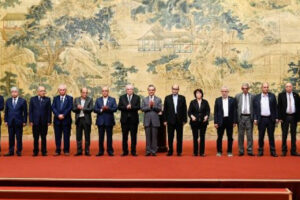The emirate’s environment agency was chosen for its work to protect endangered marine animal species
The United Nations Environment Programme has named Environment Agency Abu Dhabi’s marine ecosystem preservation and rehabilitation programmes in its top 10 global initiatives.
The announcement was made on the sidelines of the UN Biodiversity Conference meetings, which took place from December 13 to 17 in Montreal, according to an EAD press release.
The programmes to preserve and rehabilitate coastal and marine ecosystems programmes were selected after evaluations conducted in accordance with Unep’s standards and requirements.
The selection was made from among more than 150 candidates from different countries and approved by 70 government agencies.
EAD was chosen for its efforts in rehabilitating the biodiversity habitats of Abu Dhabi’s coasts and waters for endangered marine animal species.
Sheikh Hamdan bin Zayed, Ruler’s Representative in the Al Dhafra Region and Chairman of the Board of Directors of EAD, said: “We have worked in several directions to sustain our marine environments and have succeeded in restoring our fish stocks, strengthened our plans to plant and rehabilitate mangroves, and launched the region’s largest coral reef rehabilitation project.
“All of this further emphasises the emirate’s important role at a local and global level in the conservation of species and their ecosystems.
“Efforts and resources are being directed to serve the goals of sustainable development and to preserve natural resources and ensure their sustainability for future generations.”
Saving corals and marine life
The coastal and marine areas of Abu Dhabi on the southern border of the Arabian Gulf, are considered a hot spot for biodiversity, housing various habitats that support a wide range of marine species and large fish.
EAD said it has worked to improve the condition of deteriorating fish stocks depleted by as much as 85 per cent, according to its studies and surveys.
The agency said its initiative helped protect fish stocks, with data showing that Abu Dhabi is on track to achieve its goal of sustainable fisheries by 2030.
An improvement has also been seen in the sustainable fishing index for three consecutive years, rising from 8.9 per cent in 2018 to 62.3 per cent by the end of 2021.
The agency also manages the Sheikh Zayed Protected Area Network, which comprises six marine reserves representing 14 per cent of the emirate’s marine environment. It has contributed to preserving biodiversity in Abu Dhabi.
These efforts have generated positive results for habitats and species, helping to stabilise important organisms and increase the number of birds, such as flamingos, it said.
It also launched the region’s largest coral reef rehabilitation project in June 2021, with the aim of cultivating more than one million colonies of coral reefs to increase their area and mitigate the pressures on coral reefs as a result of climate change and rising temperatures on the sea floor.
Protecting mangroves
EAD said it is focused on protecting mangroves through targeted programmes for planting and rehabilitating mangrove areas and using modern technologies in agriculture, such as drones.
These initiatives were recognised by the World Economic Forum as one of the most innovative in the field of blue carbon sequestration.
Over the past 10 years, 15 million mangrove trees were planted, contributing to more than a 35 per cent increase in the area of Abu Dhabi’s mangrove trees, which today exceeds 176 square kilometres, including natural and cultivated trees.
Studies by the agency revealed the ability of mangroves in Abu Dhabi to store carbon at a rate of 0.5 tonnes per hectare a year, which is equivalent to 8,750 tonnes for the entire emirate, and to the energy consumption of 1,000 homes per year.
Its initiatives are also helpting to preserve the emirate’s seagrass meadows, contributing to the stability of dugong numbers in their natural habitat.
Abu Dhabi is home to the second-largest group of dugongs in the world, with numbers exceeding 3,000 ― the highest density per square metre in the Arabian Gulf region.
Studies also showed an increase in the number of turtles and their population stability in the emirate in recent years, with numbers estimated at about 5,000 hawksbill turtles, green turtles and loggerhead turtles.
EAD said it also ensured the protection of three types of dolphins and one type of porpoise. The emirate’s waters host a population of more than 700 dolphins, most of which live in marine protected areas ― including the largest group of Indian Ocean humpback dolphins in the world.
“Our marine habitats thrive despite the challenges they face due to high temperatures and increased salinity in the emirate’s waters ― which is unique in a world where the effects of climate change are increasing,” said Dr Shaikha Salem Al Dhaheri, secretary general of EAD.
“Our natural habitats face pressure due to the rapid development in the region, as well as coastal development activities and projects related to housing, tourism and infrastructure.
“This has impacted critical coastal and marine habitats. We have taken proactive measures to balance the requirements of economic and social development, sustainable exploitation of resources, and the development of rehabilitation initiatives and ecosystem restoration within the framework of the emirate’s plans and strategies.”















